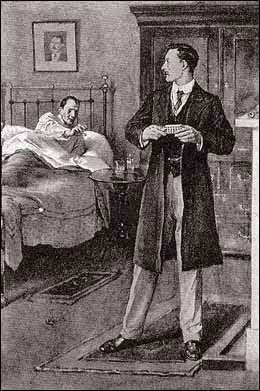“He's dying, Dr. Watson,” said she. “For three days he has been sinking, and I doubt if he will last the day.”
 |
| November 1913 |
In The Adventure of the Dying Detective, the famous sleuth of 221B, Baker Street, London, is very ill and dying from a rare eastern disease. At least, that is what his landlady Mrs. Hudson and his friend Dr. Watson fear. As would his readers who may be forgiven for their initial startled reaction to Holmes' dire state.
Watson is especially horrified when he finds his friend confined to bed and ailing from a disease he didn’t know Holmes had. The detective is delirious and incoherent and his face is pale and gaunt with bones sticking out of it. His sickly appearance sends a chill into Watson’s heart.
Lest we forget, Holmes is a master of disguise and he uses it most effectively to divert Watson’s attention from his real purpose—to expose Culverton Smith as the man who murdered his own nephew, Victor, by injecting him with the same virus that has apparently made Holmes sick.
Smith is an expert in tropical diseases, including the one afflicting the detective, and he has already tried to kill Holmes in a similar manner. Only the sleuth knows about it.
Watson is especially horrified when he finds his friend confined to bed and ailing from a disease he didn’t know Holmes had. The detective is delirious and incoherent and his face is pale and gaunt with bones sticking out of it. His sickly appearance sends a chill into Watson’s heart.
Lest we forget, Holmes is a master of disguise and he uses it most effectively to divert Watson’s attention from his real purpose—to expose Culverton Smith as the man who murdered his own nephew, Victor, by injecting him with the same virus that has apparently made Holmes sick.
Smith is an expert in tropical diseases, including the one afflicting the detective, and he has already tried to kill Holmes in a similar manner. Only the sleuth knows about it.
 |
| Holmes in his bed. |
Holmes is secretive and ingenious as he instructs Watson to summon Culverton Smith to his house at any cost, ostensibly to cure him but in reality to unmask him in a final showdown.
I liked Watson’s role in this story. He shows his worth as a true and loyal friend when he doesn't ask too many questions and does exactly as Holmes bids him to do. Admirably, Watson is not upset when Holmes summons another doctor to cure him or when Holmes speaks to him in a brusque manner and orders him around.
In the end Watson realises why, as his dear friend solves Victor’s murder and his own attempted murder from his so-called deathbed.
The thing with Arthur Conan Doyle's fiction is that, having tasted one, you want several more helpings of his well-crafted stories.
The Adventure of the Dying Detective was first published in Collier’s Weekly Magazine in November 1913 and subsequently in The Strand Magazine in December 1913. Later, it formed one of eight stories in His Last Bow collection. The short story is available free online.
I liked Watson’s role in this story. He shows his worth as a true and loyal friend when he doesn't ask too many questions and does exactly as Holmes bids him to do. Admirably, Watson is not upset when Holmes summons another doctor to cure him or when Holmes speaks to him in a brusque manner and orders him around.
In the end Watson realises why, as his dear friend solves Victor’s murder and his own attempted murder from his so-called deathbed.
The thing with Arthur Conan Doyle's fiction is that, having tasted one, you want several more helpings of his well-crafted stories.
The Adventure of the Dying Detective was first published in Collier’s Weekly Magazine in November 1913 and subsequently in The Strand Magazine in December 1913. Later, it formed one of eight stories in His Last Bow collection. The short story is available free online.
have not read this one. Sounds like a nice misdirection, though.
ReplyDeleteCharles, I read a Holmes' story after a long time and I'm hoping to (re)read some of his other short stories.
DeleteI read the complete Holmes as a compilation when I was a teenager, so I have probably digested this one. Truthfully, I can't remember many (any?) and it's not my preferred setting for my current reading.
ReplyDeleteCol, I assume all his short stories are compiled in various collections and none of those would be new to someone who is familiar with his work. I don't have a setting for my reading — I read anything, any time.
DeleteNicely summed up. I once had the pleasure of writing a radio play adaptation of The Sign of the Four.
ReplyDeleteRon, thank you. I have not read THE SIGN OF THE FOUR. I have never listened to radio plays or audio books and must try it some time.
DeleteI have read no Sherlock Holmes novels or stories, so I will start closer to the beginning. But this one sounds interesting.
ReplyDeleteTracy, although Conan Doyle's short stories are interesting, I'd recommend his novels among which my favourite is HOUND OF THE BASKERVILLES, probably because I first read it partially in school. I intend to read it again.
Delete